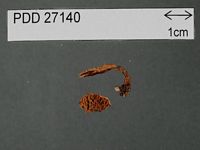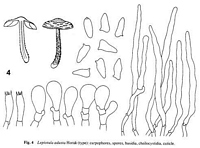|
 Lepiota adusta Lepiota adusta
SynonymsLepiotula adusta
BiostatusPresent in region - Indigenous. Endemic
Images (click to enlarge)
Caption: Fig. 15. D. Lepiota adusta (HORAK) (type) : spores. | 
Caption: Dried type specimen
Owner: Herb PDD |  |
Article: Horak, E. (1980). On Australasian species of Lepiota S.F. Gray (Agaricales) with spurred spores. Sydowia 33: 111-144.
Habitat: Habitat. - On soil among litter in coastal, mixed forests. - New Zealand.
Notes: Remarks. - As pointed out in the key L. adusta comes macroscopically close to two other
Australasian species of Lepiota, viz. L. atrata HORAK (New Caledonia) and L. exocarpi
CLEL. (Australia). These three species are, however, well separated by their specific microscopic
characters (shape-size of spores and cheilocystidia).
Article: Horak, E. (1980). Fungi Agaricini Novazelandiae. IX. Lepiotula (Maire) Locquin ex Horak. New Zealand Journal of Botany 18(2): 183-188 (http://www.rsnz.org/publish/abstracts.php).
Description: Pileus 10-20 mm diam., conico-convex becoming umbonate or obtusely campanulate, centre black or fuliginous, breaking up into concolorous, concentric velutinous or tomentose bands and squamules on a paler background, dry, veil remnants absent, margin estriate. Lamellae free, ventricose, crowded, whitish when young turning to pale argillaceous, edge albofirmbriate. Stipe 20-40 x 3-5 mm, cylindric or attenuated towards apex, pale brown, covered by small, irregularly shaped, black squamules and short rings from veil towards base, cortina absent, fibrillose, dry, solid, single in groups. Context dark brown beneath cuticle. Odour sourish. Chemical reactions on pileus:KOH - negative. Spores 7-8.5 x 2.5-3.5 µm, spurred, hyaline, dextrinoid, smooth, germ pore absent. Basidia 1&-22 x 6-7 µm, 4-spored. Cheilocystidia 15-25 x 7-12 µm, clavate or vesiculose, thin-walled, hyaline, forming sterile seam on gill edge. Pleurocystidia absent. Cuticle a palisade of erect cylindric or subfusoid cells (80-200 µm x 6-12 µm), with brownish pigment in membrane or encrusting pigment. Clamp connections numerous.
Habitat: On soil in forests (under Dacrydium, Metrosideros, Dracophyllum). New Zealand.
|